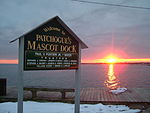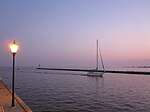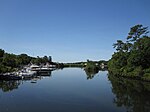Davis Park is a hamlet in the Town of Brookhaven, Suffolk County, New York, United States. It is located on Fire Island, a barrier island separated from the southern side of Long Island by the Great South Bay off the South Shore village of Patchogue. It lies within the Fire Island National Seashore.
Davis Park is a Fire Island beach community which acts as a destination for families and singles alike, who are home owners, renters, boaters, and ferry goers.
Davis Park is commonly used to refer to three contiguous areas in the hamlet of Davis Park, namely, Davis Park, Leja Beach, and Ocean Ridge. The three areas share services and social life, and are separated from other communities on Fire Island.
Technically, Davis Park refers to the business and public part of the community on both sides of Trustees' Walk, in contrast to the sections known as Leja Beach (to the west of Trustees Walk bounding Center Walk to the North and South) and Ocean Ridge (to the east).
Davis Park is the easternmost private community on Fire Island (formerly, there were other communities to the east that were removed by the National Park Service after the creation of Fire Island National Seashore in 1964, they included Bayberry Dunes, Whalehouse Point and Long Cove).
The community extends along approximately 3/4 mile (1.25 km) of beachfront, and is approximately 330 yards (0.3 km) wide at its widest and 190 yards (0.17 km) wide at its narrowest point (dune to bay, excluding ocean beach width). Davis Park is bordered by extensive wilderness areas to both east and west. The Watch Hill facility of the National Park Service (with a small marina, restaurant, campground, nature trail and seasonal tours and activities) is approximately 1/2 mile (0.8 km) east, and Water Island (a community, not a separate island) is approximately one mile (1.6 km) to the west. Davis Park lies approximately 13.9 miles (22.3 km) from the eastern end of Fire Island at Moriches Inlet and 16.3 miles (26.3 km) from the western end of Fire Island at Democrat Point (in Robert Moses State Park).
The United States Post Office at Davis Park (open July and August only) lies at approximately 40°41′04″N 73°00′15″W.
To reach Davis Park, one must travel by boat. A ferry (seasonal, mid-March to end of November) is available which departs from Sandspit Park in Patchogue on the mainland of Long Island and travels approximately for 15-20 minutes across the Great South Bay.
Davis Park has approximately 350 homes (130 in Ocean Ridge and 220 in Davis Park), one general store and grill, one restaurant and one bar. The restaurant and bar are the only ones on Fire Island with a clear view of the bay and the ocean. There is one unpaved road, commonly called the Burma Road, and wooden boardwalks. There are no cars (except for emergency, utility and construction vehicles and a very limited number of private vehicles, which are only allowed through a strict permit process regulated by the National Park Service). There are no street lights except in the marina area, resulting in fine night time star-gazing. There are, a Brookhaven town public marina, a (seasonally) lifeguarded section of beach and public restrooms and showers.
Davis Park is protected by the all-volunteer Davis Park Fire Department and by Suffolk County Police. The non-for-profit Davis Park Medical Association owns a house, "Bedside Manor," on the dune in Ocean Ridge, which is rented in season to doctors and nurse practitioners at a below-market rate in exchange for their agreement to provide basic medical services through scheduled office hours and on-call availability. Bedside Manor is equipped with basic medical equipment and supplies. A helipad provides emergency evacuation capability.










